THM - Conti
About
A writeup for a TryHackMe room Conti completed on 23 July 2023.
Scenario
Some employees from your company reported that they can’t log into Outlook. The Exchange system admin also reported that he can’t log in to the Exchange Admin Center. After initial triage, they discovered some weird readme files settled on the Exchange server.
Below is a copy of the ransomware note.

Below are the error messages that the Exchange admin and employees see when they try to access anything related to Exchange or Outlook.
Exchange Control Panel:

Outlook Web Access:

Task: You are assigned to investigate this situation. Use Splunk to answer the questions below regarding the Conti ransomware.
Gathering log information
Using index="main" and setting to “all time” for the date range shows 28145 events in splunk.

Looking at the Users field, I see different users that are logged.
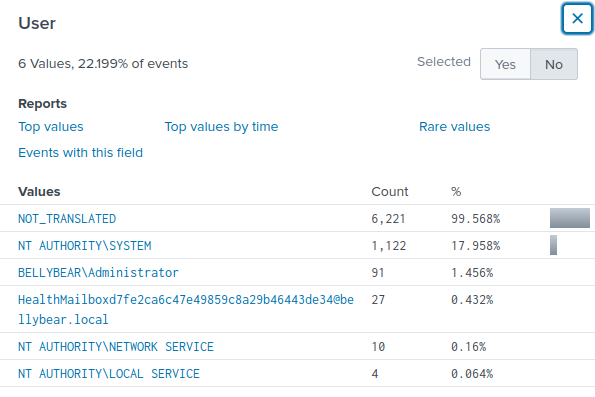
Finally, from sourcetype, logs ingested are from WinEventLog, Sysmon and IIS.
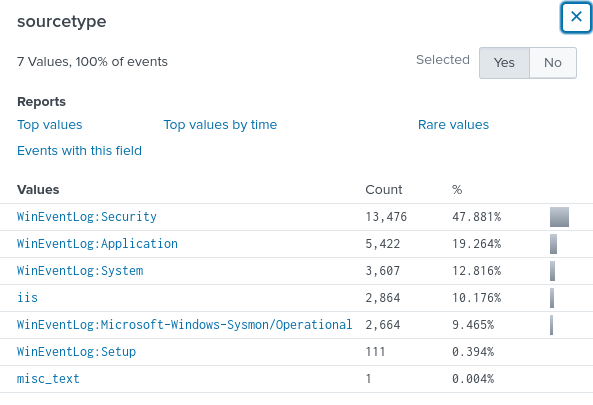
Can you identify the location of the ransomware?
To start my search, I used the following filter to filter for and create a table to see all Image in Splunk. EventCode=1 denotes process creation in Sysmon. I decided to filter for this event code as the ransomware has successfully run, and so using this filter will potentially show me where the ransomware is located.
index="main" EventCode=1
| table Image
| dedup Image
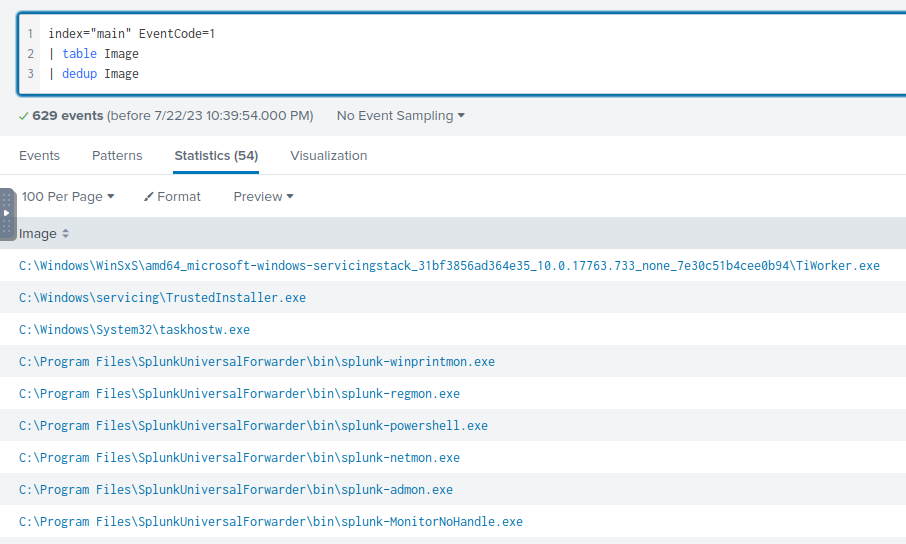
However, there are many Image rows which contain “Splunk” and is not what I am looking for. Thus, I updated the filter to the one below to remove all the log entries that I am not interested in.
index="main" EventCode=1 NOT "Splunk"
| table Image
| dedup Image
In the image below, I see a row with C:\Users\Administrator\Documents\cmd.exe. The typical location of cmd.exe will be at C:\Windows\System32\cmd.exe. C:\Windows\System32\cmd.exe also appears and having two exe with the same name is suspicious.
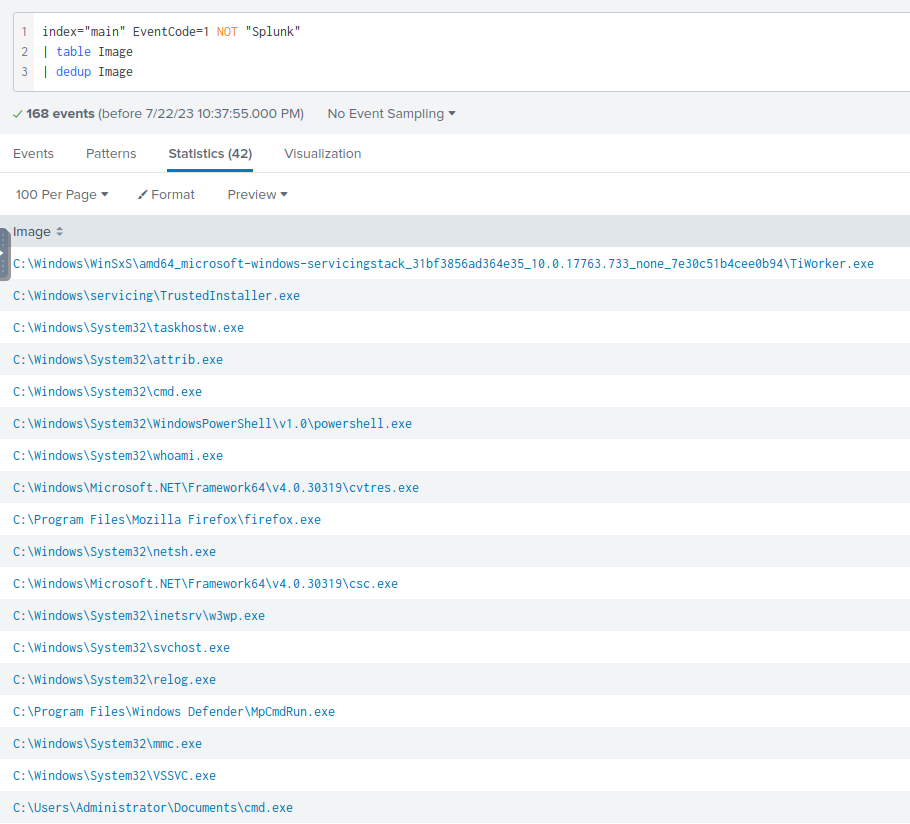
C:\Users\Administrator\Documents\cmd.exe is most likely masquarading as a legitimate Windows exe cmd.exe , which makes it suspicious and may be the ransomware.
Digging further using the filter below, I manage to find more suspicious events from C:\Users\Administrator\Documents\cmd.exe. EventCode=11 is used to filter for file creation events.
index="main" EventCode=11 "C:\\Users\\Administrator\\Documents\\cmd.exe"
| table Image TargetFilename
C:\Users\Administrator\Documents\cmd.exe created multiple readme.txt in different folders, and this readme.txt likely shows the ransom note from the scenario. Whats more interesting in the following image is that we see an Image C:\Windows\system32\wbem\unsecapp.exe creating C:\Users\Administrator\Documents\cmd.exe.
C:\Windows\system32\wbem\unsecapp.exe is a legitimate Windows exe. From this blog, unsecapp stands for Universal Sink to Receive Callbacks from Applications, and is needed for Windows to receive and responds to requests from other applications.
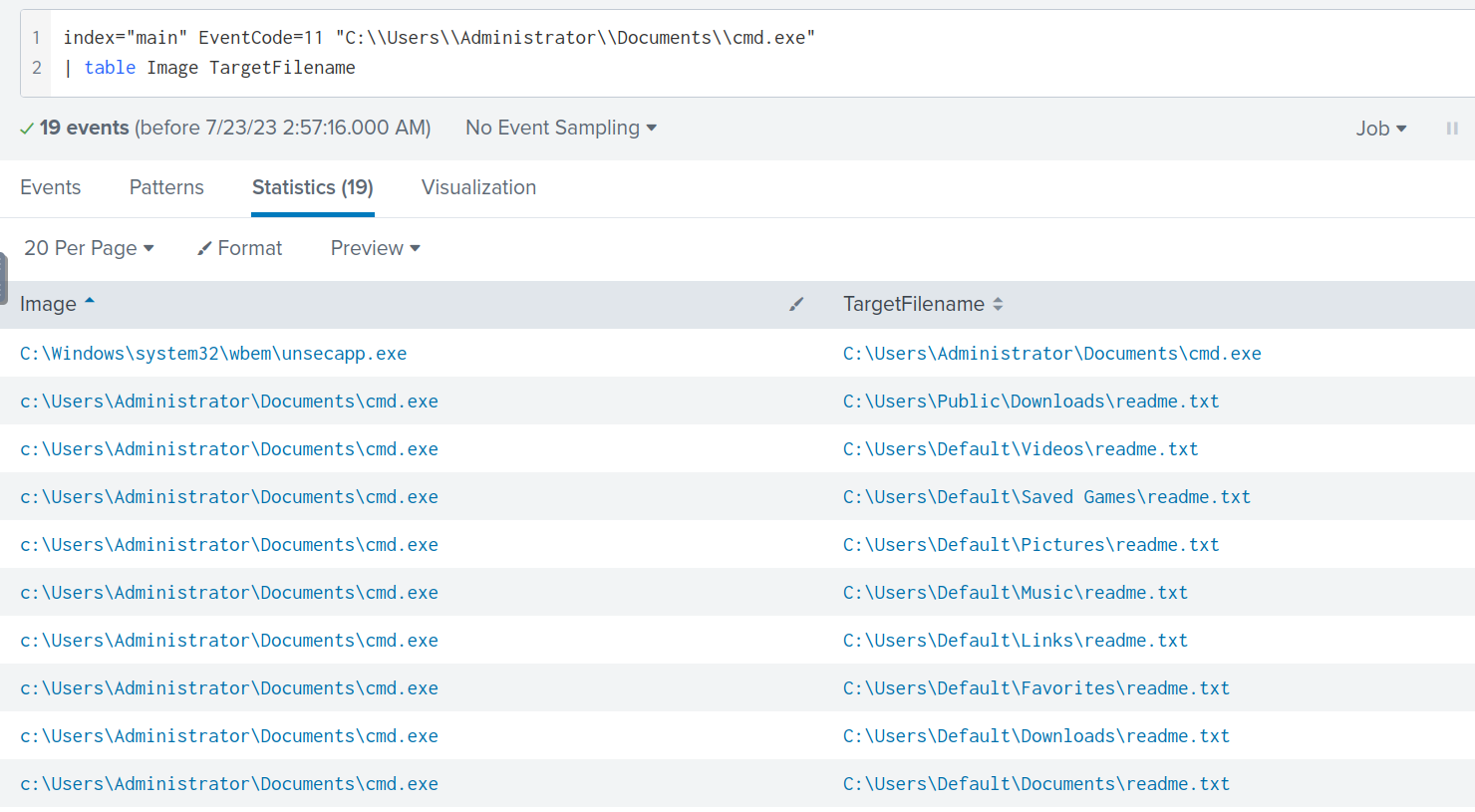
Answer: C:\Users\Administrator\Documents\cmd.exe
What is the Sysmon event ID for the related file creation event?
Sysmon EventCode=11 denotes file creation events.
Answer: 11
Can you find the MD5 hash of the ransomware?
Knowing the location of the ransomware, I used it to further refine my filter to search for events that logged this file. Additionally, I searched for events where the Hashes field is not empty.
index="main" "C:\\Users\\Administrator\\Documents\\cmd.exe" Hashes=*
The following image shows the log entry, which includes the MD5 hash.
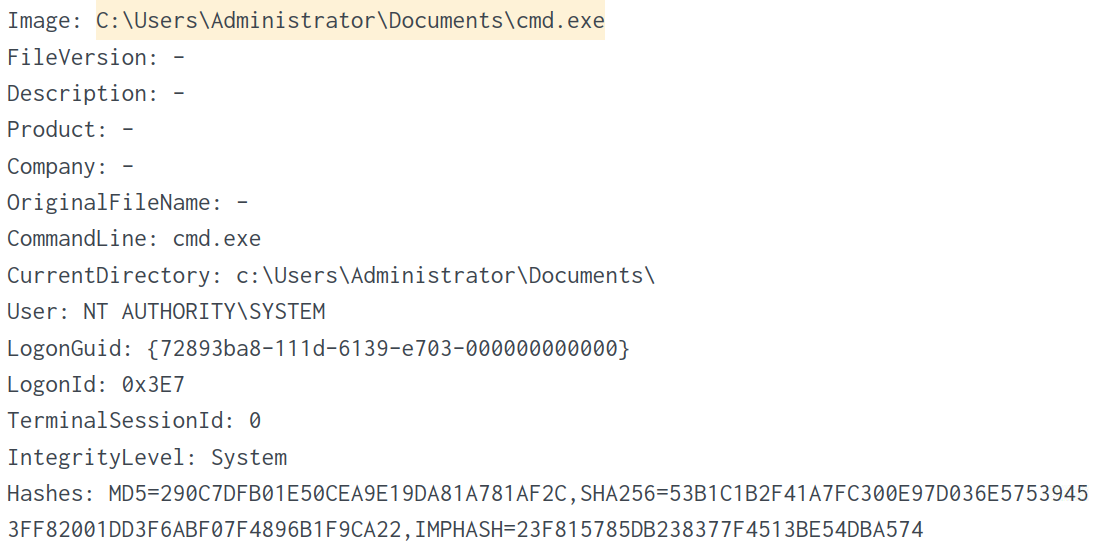
Searching for the hash on VirusTotal also points to the file being malicious.
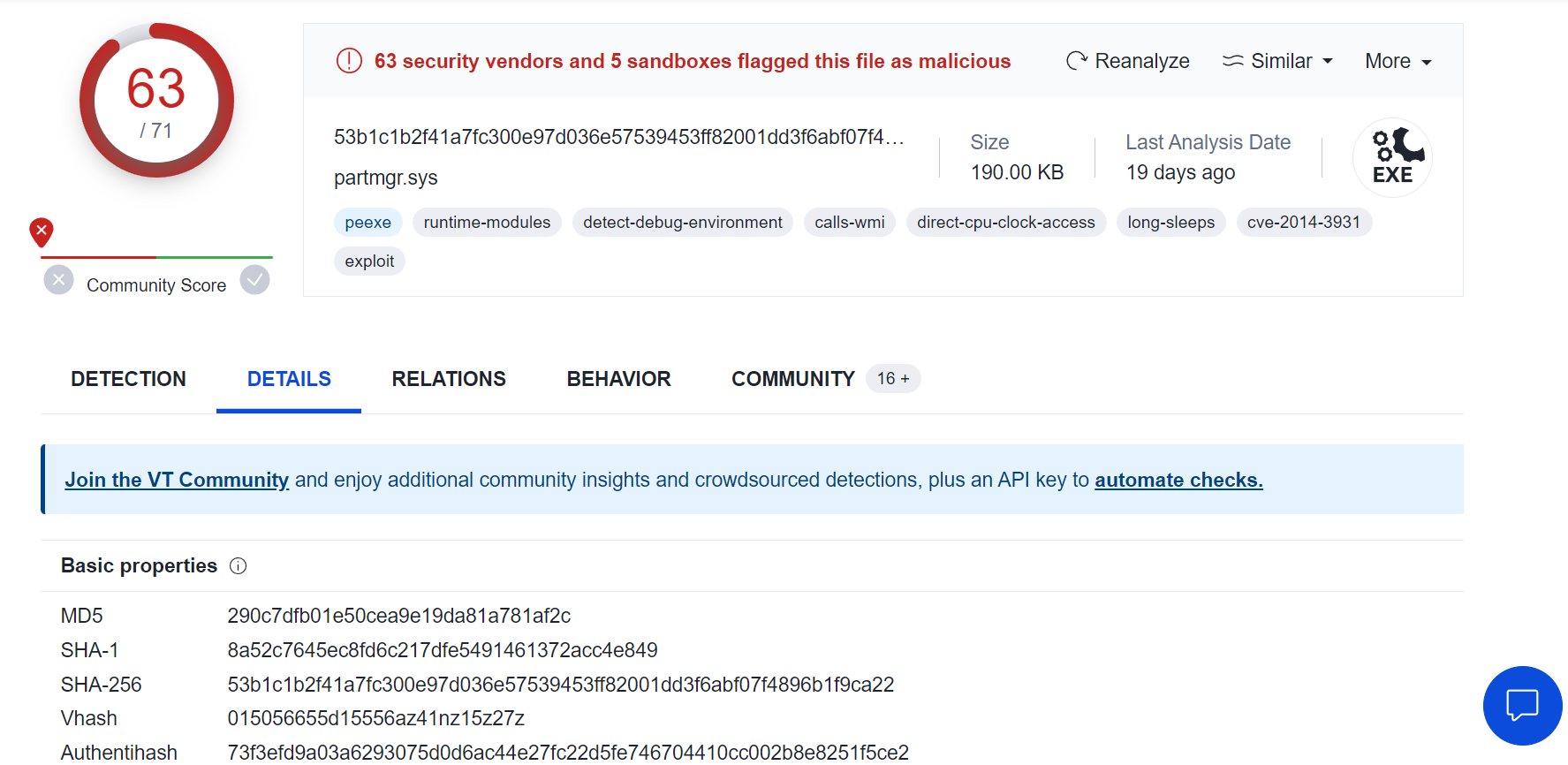
Answer: 290C7DFB01E50CEA9E19DA81A781AF2C
What file was saved to multiple folder locations?
Looking through the table created with the filter below, I saw multiple readme.txt files being created in different folders.
index="main" EventCode=11 "C:\\Users\\Administrator\\Documents\\cmd.exe"
| table Image TargetFilename

Answer: readme.txt
What was the command the attacker used to add a new user to the compromised system?
Looking at the ComputerName field using the below filter, I know the name of the compromised system is WIN-AOQKG2AS2Q7.bellybear.local .
index="main" "C:\\Users\\Administrator\\Documents\\cmd.exe"
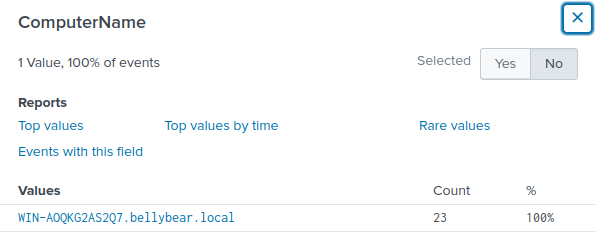
Changing the filter to the one shown below shows a log entry where a user account “securityninja” is created. EventCode=4720 is used as it denotes new user account being created in Sysmon.
index="main" ComputerName="WIN-AOQKG2AS2Q7.bellybear.local" EventCode=4720

I know that a user account “securityninja” is created, thus I changed my filter to the following.
index="main" "securityninja"
Looking at the CommandLine field, I can see the command used to create the new user.
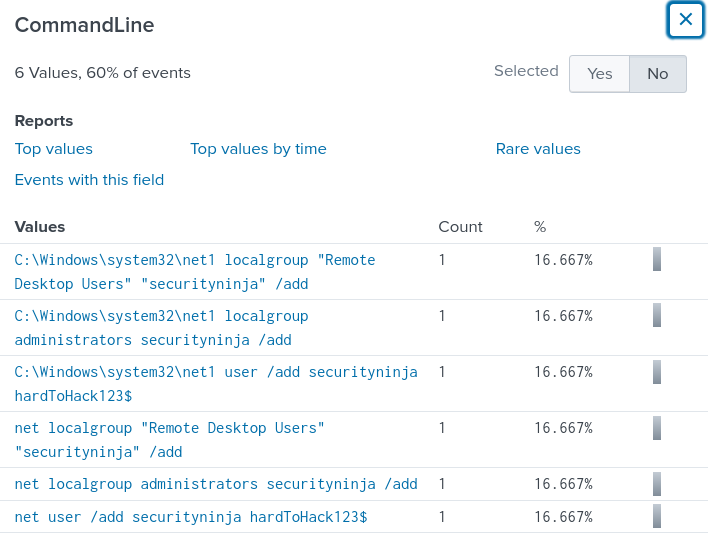
Answer: net user /add securityninja hardToHack123$
The attacker migrated the process for better persistence. What is the migrated process image (executable), and what is the original process image (executable) when the attacker got on the system?
I googled for the event code sysmon used for process migration on Google using the following search term “sysmon migrated process event code”. The first link showed that Sysmon logs this event as EventCode=8.
I changed my filter to the following.
index="main" EventCode=8
Two log entries are returned. The screenshot below shows the first log entry and the migrated process as C:\Windows\System32\lsass.exe and the original process is C:\Windows\System32\wbem\unsecapp.exe.
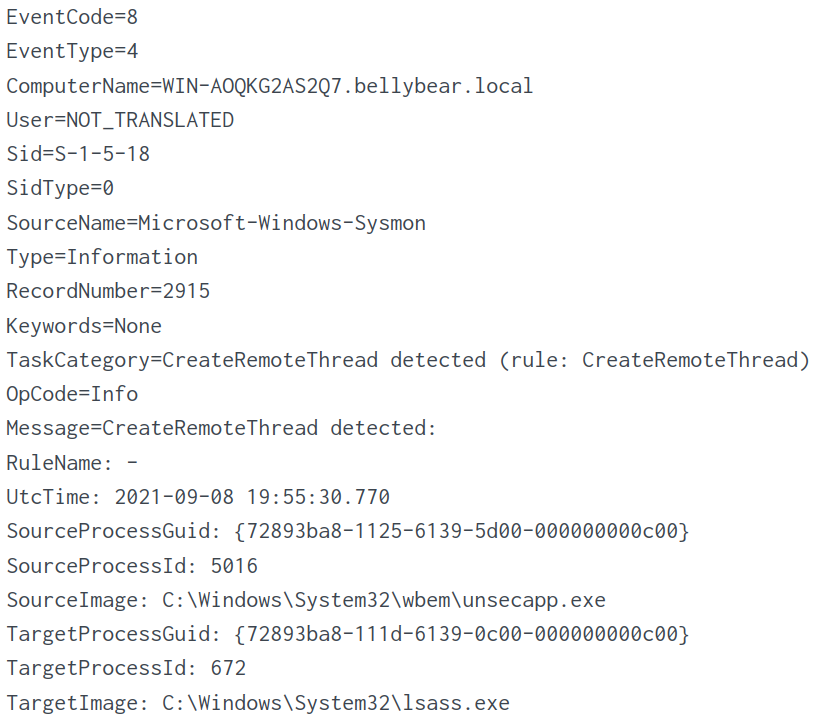
Looking at the second log entry, the migrated process is C:\Windows\System32\wbem\unsecapp.exe and the original process is C:\Windows\System32\WindowsPowerShell\v1.0\powershell.exe.
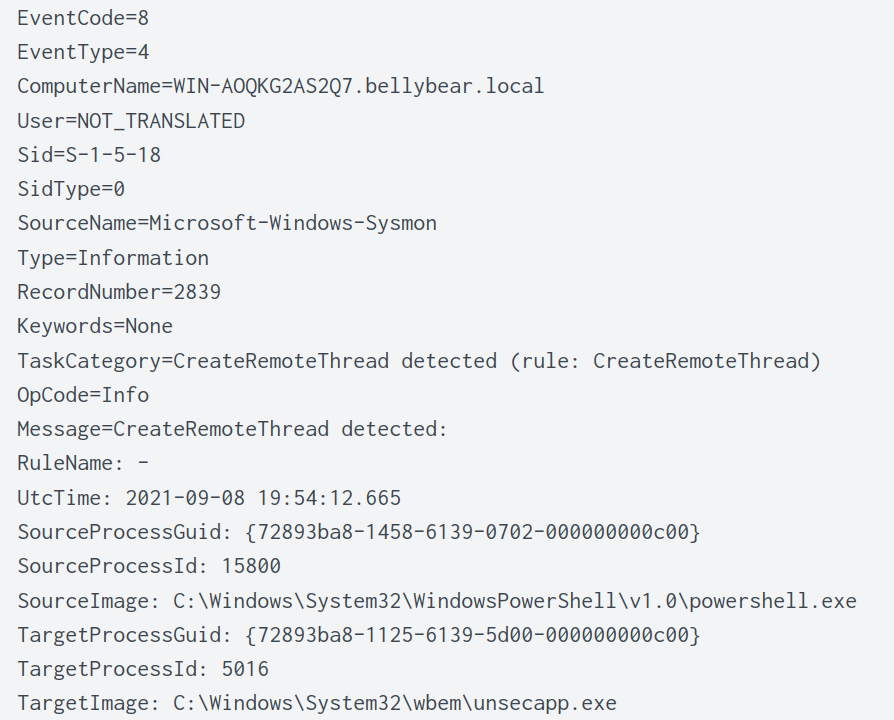
As the question is asking for the original process image when the attacker got on the system, the more likely answer is C:\Windows\System32\WindowsPowerShell\v1.0\powershell.exe;C:\Windows\System32\wbem\unsecapp.exe and not C:\Windows\System32\wbem\unsecapp.exe;C:\Windows\System32\lsass.exe.
C:\Windows\System32\wbem\unsecapp.exe;C:\Windows\System32\lsass.exe is possibly used as a process migration for later stages.
Answer: C:\Windows\System32\WindowsPowerShell\v1.0\powershell.exe;C:\Windows\System32\wbem\unsecapp.exe
The attacker also retrieved the system hashes. What is the process image used for getting the system hashes?
Local Security Authority Server Service (LSASS) credential dumping is a common TTP in recovering password hashes. LSASS is a process in Windows responsible for enforcing security policies on system. LSASS is responsible for verifying user logins into Windows, handling password changes, and creating access tokens.
Recovering a dump of LSASS will allow adversaries to conduct further pivoting into the network using pass-the-hash attack. This blog is a great reference for LSASS credential dumping.
Using the same filter as the above question, and looking at the first log entry shows a process migration from C:\Windows\System32\wbem\unsecapp.exe to C:\Windows\System32\lsass.exe .
index="main" EventCode=8

Answer: C:\Windows\System32\lsass.exe
What is the web shell the exploit deployed to the system?
IIS are Exchange logs and these logs are also ingested into Splunk. I thus constructed the following filter to only see IIS logs.
index="main" sourcetype="iis"
Looking at the s_ip field, I can see four different values logged. s_ip is the IP address of the server where the log entry is generated. In this case, s_ip will denote the exchange web server. I guess the server address will most likely be 10[.]10[.]10[.]6.

In order to further reduce the number of events seen I added the filter for s_ip to show only 10[.]10[.]10[.]6.
index="main" sourcetype="iis" s_ip="10.10.10.6"
Looking at the cs_uri_stem field, I see the following values.
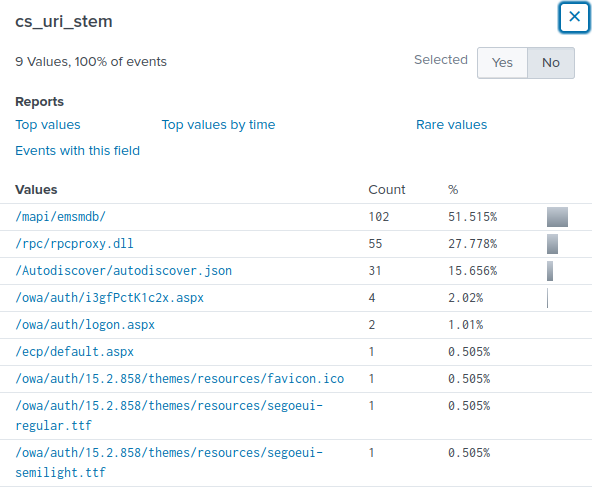
/ecp/default.aspx and /owa/auth/logon.aspx are seen in the images under the scenario section. I also noticed /owa/auth/i3gfPctK1c2x.aspx which seems to be suspicious. Using this filter,
index="main" sourcetype="iis" s_ip="10.10.10.6" cs_uri_stem="/owa/auth/i3gfPctK1c2x.aspx"
I noticed in the first log entry the c_ip is listed as 10[.]10[.]10[.]2. For IIS logs, c_ip denotes the IP address of the client that made the request.

I wanted to confirm that 10[.]10[.]10[.]6 belongs to WIN-AOQKG2AS2Q7.bellybear.local which we know is compromised. Thus, I used the following filter to create the table shown below.
index="main" "WIN-AOQKG2AS2Q7.bellybear.local" "10.10.10.6" "10.10.10.2"
| table SourceIp SourceHostname DestinationIp DestinationHostname
From the table below, the SourceHostname field shows WIN-AOQKG2AS2Q7.bellybear.local while the SourceIp is 10[.]10[.]10[.]6. Therefore, I can conclude that WIN-AOQKG2AS2Q7.bellybear.local has the IP address of 10[.]10[.]10[.]6 while the adversary IP address is 10[.]10[.]10[.]2.

Answer: i3gfPctK1c2x.aspx
What is the command line that executed this web shell?
I know that the web shell is i3gfPctK1c2x.aspx and thus, I used this as part of the filter and also searched for EventCode=1 which stands for process creation.
index="main" "i3gfPctK1c2x.aspx" EventCode=1
There is only one log entry returned, which contains the command line that executed the web shell.
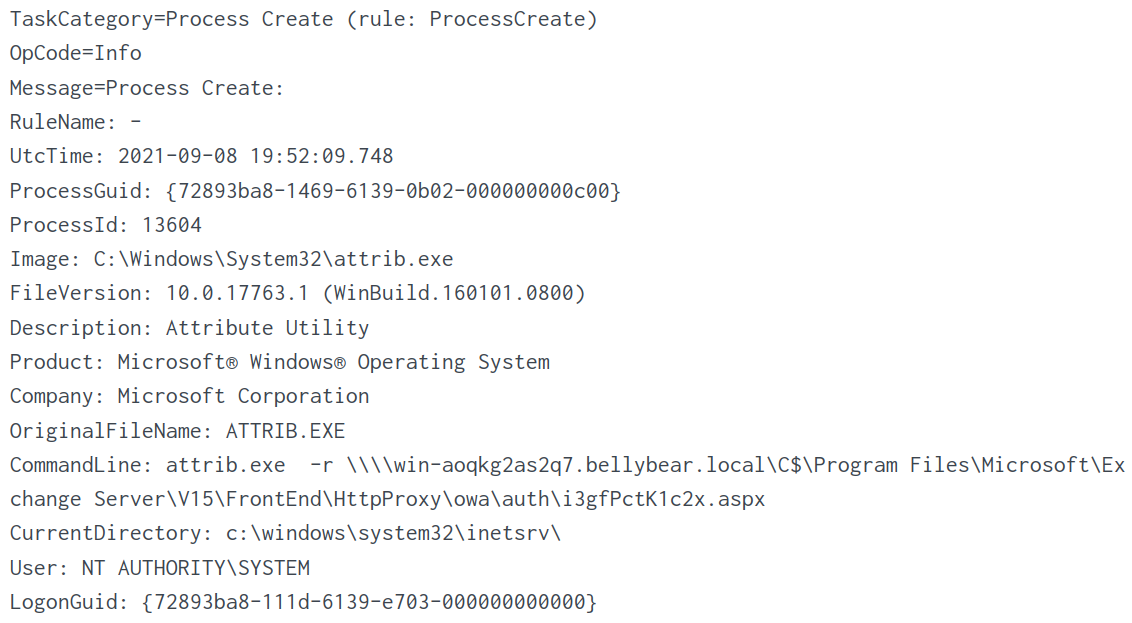
Answer: attrib.exe -r \\\\win-aoqkg2as2q7.bellybear.local\C$\Program Files\Microsoft\Exchange Server\V15\FrontEnd\HttpProxy\owa\auth\i3gfPctK1c2x.aspx
What three CVEs did this exploit leverage?
This blog talks about the three vulnerabilities associated with Conti. From national vulnerability database (NVD) these three vulnerabilities are:
CVE-2020-0796
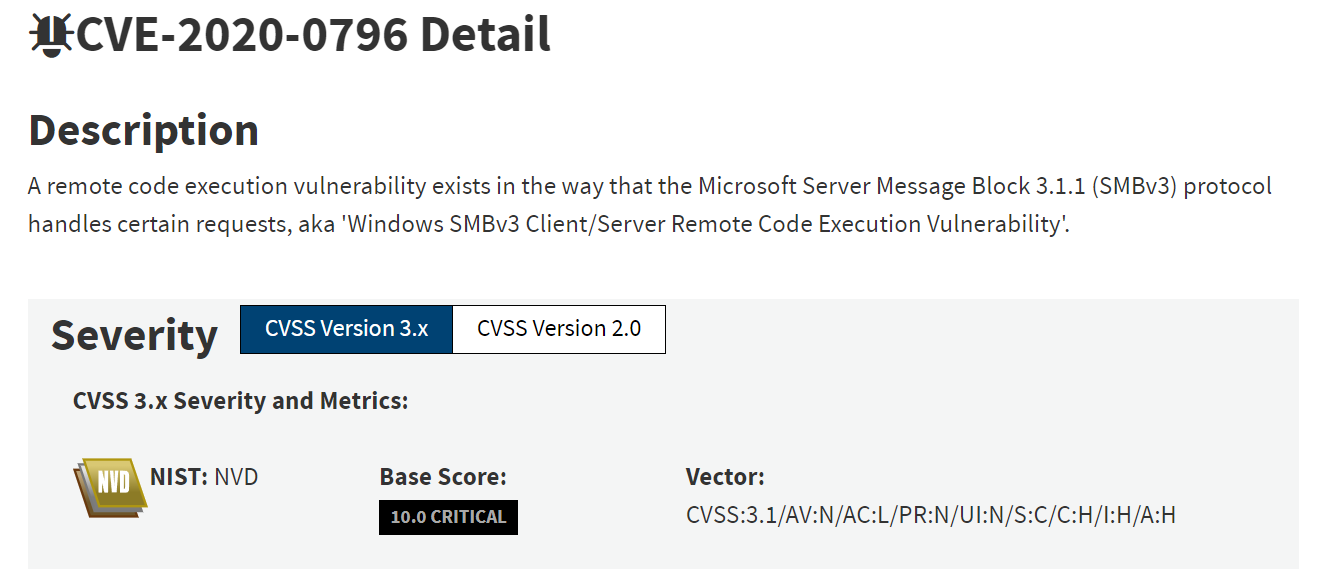
CVE-2018-13374
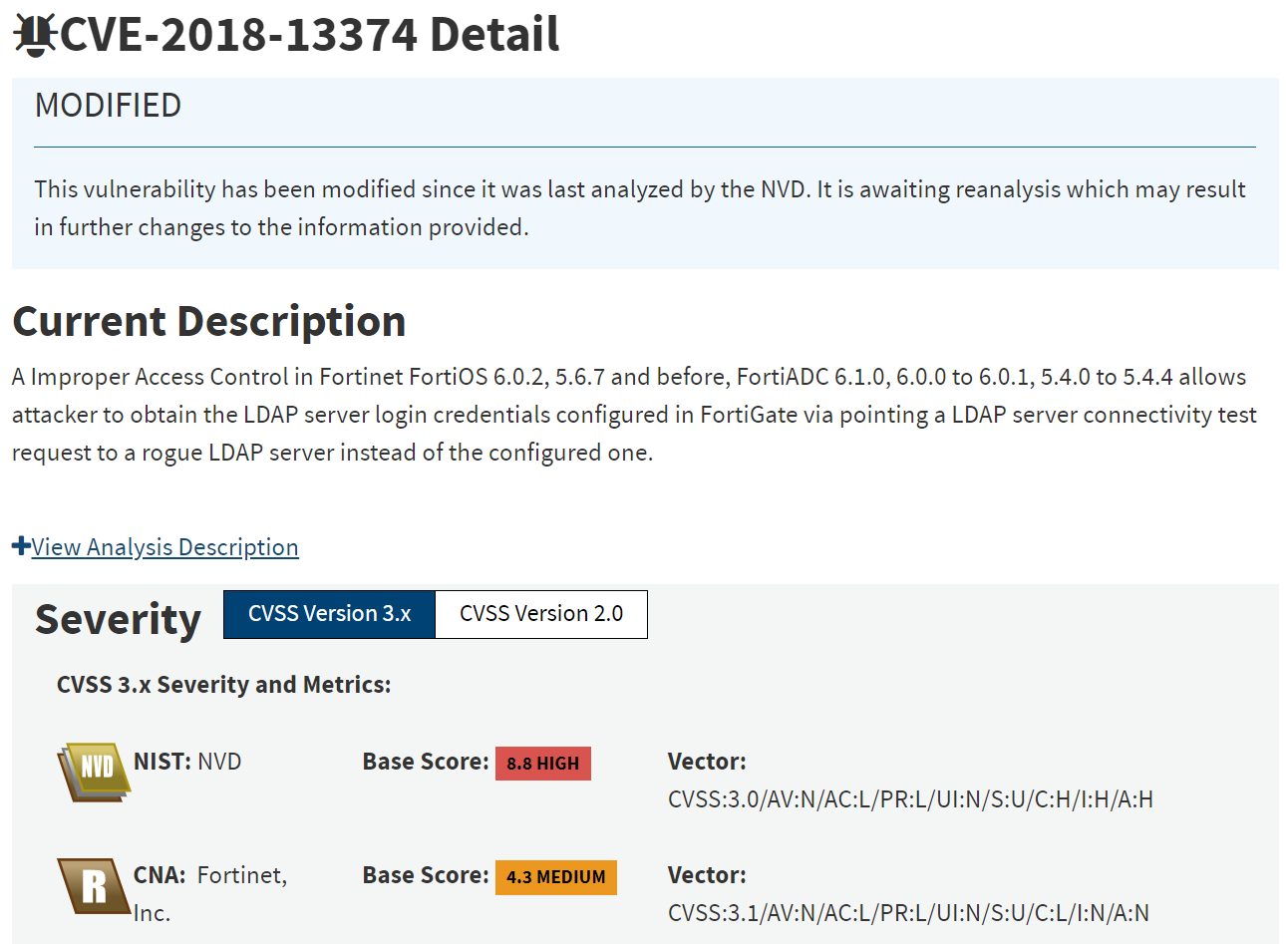
CVE-2018-13379

Answer: CVE-2020-0796, CVE-2018-13374, CVE-2018-13379